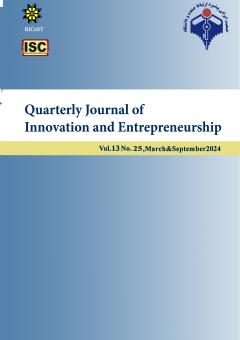Analysis of the Impact of Innovation and the Mediating Role of Organizational Culture on the Organization's strategy (Case Study: Ports and Maritime Organization of the Islamic Republic of Iran)
Subject Areas : New scientific findings in the fields of innovation and entrepreneurship
mohammad javad Golzadeh
1
![]() ,
Saber Khandan Alamdari
2
,
Saber Khandan Alamdari
2
![]() ,
Neda Farahbakhsh
3
,
Neda Farahbakhsh
3
![]()
1 - Graduated from the specialized doctorate level, Department of Technology Management - Innovation Management, Roudhen Branch, Islamic Azad University, Roudhen, Iran
2 - Assistant Professor and Faculty Member, Department of Industrial Management, Roudhen Branch, Islamic Azad University, Roudhen, Iran
3 - Assistant professor and faculty member, Department of Economic Sciences, Roudhen Branch, Islamic Azad University, Roudhen, Iran
Keywords: Successfulness of an Organization’s Strategies, Organizational Culture, Organizational Innovation ,
Abstract :
The purpose of this research is to analyze the impact of innovation and the mediating role of organizational culture on the organization's strategy, as well as to determine the relationships between these factors, which is descriptive in terms of its practical purpose and method, and of the causal correlation type. The statistical sample of this research was 266 employees and employees of the headquarters department of the Ports and Maritime Organization of the Islamic Republic of Iran, who were selected using a simple random sampling method. The reliability of the questionnaire was determined by Cronbach's alpha (0.95). Data analysis was done through descriptive statistics and inferential statistics. The Structural Equation Model (SEM) was used to examine the relationships between the constructs of this research using Emus software. The ideal goal of this research is to provide suitable solutions to guide managers and planners and designers of organizations, in order to choose the appropriate organizational culture that will provide a suitable environment for the development of talents and creativity of people in the organization. and finally lead to formulating appropriate strategies to achieve the goals of the organization. The findings of the research state: 1 . Organizational culture has a direct effect on organizational innovation. 2. Organizational innovation and organizational culture have a direct impact on the success of the organization's strategy. 3 . Organizational culture affects the success of the organization's strategy. 4 . Hardware and software capacities have an effect on knowledge capital, expertise capital and skill capital. 5 . The aforementioned funds also affect surveillance and lead to service innovation and process innovation. 6. The mentioned components lead to organizational innovation and organizational innovation also affects task performance, human performance, innovative performance and quality performance. 7. Finally, the mentioned components lead to the improvement of organizational performance
1. تراسبی، د. (1387). اقتصاد و فرهنگ. (کاظم فرهادی مترجم).تهران: نشر نی (نشر اصلی اثر 2001).
2. تراسبی، د. (1393). اقتصاد سیاست فرهنگی. (سوسن علایی مترجم). تهران: انتشارات سوره مهر (نشر اصلی اثر 2010).
3. درزی، ق. (1402). مطالعه تطبیقی میانرشتهای قرآن و عهدین، گونهها و نمونهها. نشریه تحقیقات علوم قرآن و حدیث، 57، 25–42.
4. شریفی، س. م.،محمدی، ح. ع.، و انصاری، ن. (1397). مدیریت منابع انسانی در صنایع خلاق. انتشارات مدیریت صنعتی.
5. محمدی،م.، حاجی¬ زاده،پ. و کمالیان، ی. (1397). سازمان صنایع خلاق. پژوهشکده سیاست¬پژوهی و مطالعات راهبردی حکمت.
6. Baeker, G. (2017). cultural economies What Are They and How Do We Build Them? Economic Development Journal, 16(2), 37–43.
7. Banks, M. (2007). The Polotics of Cultural Work. In the Open University. Palgeave Macmillan.
8. DCMS. (1998). Creative Industries Mapping Document. National Statistics on the Creative Industries.
9. DCMS, Statman, M., & Glushkov, D. (2016). Classifying and Measuring the Creative Industries. Journal of Portfolio Management, 42(2), 140–151.
10. Denatale, D., & Wassall, G. H. (2007). The Creative Economy: A New Definition (p. 64). NEW England Foundation for the Art (nefa).
11. Department of Culture, media and sports. (2016). Creative Industries Economic Estimates\Methodology.
12. ESSnet-CULTURE. (2012). European Statistical System Network on Culture - Final Report. In EssnetCulture.
13. Galloway, S., & Dunlop, S. (2007). A Critique of Definitions of The Cultural and Creative Industries in Public Policy. International Journal of Cultural Policy, 13(1), 17–31.
14. Garnham, N. (2005). From Cultural to Creative Industries. International Journal of Cultural Policy, 11(1), 15–29. https://doi.org/10.1080/10286630500067606
15. Hartley, J. (Ed.). (2005). Creative Industries. Blackwell Publishing.
16. Hartley, J., Potts, J., Cunningham, S., Flew, T., Keane, M., & Banks, J. (2013). Key Concepts in Creative Industries. Sage.
17. Heng, T. M., Choo, A., & Ho, T. (2003). Economic Contributions of Singapore’s Creative Industries. Economic Survey of Singapore, First Quarter, 51–75. http://www.ico-d.org/database/files/library/singapore.pdf
18. Hesmondhalgh, D., & Baker, S. (2011). Creative Labour. Routledge.
19. Johnson, T. G. (2019). Existing Conceptual Models of Arts and Culture: An Inventory (p. 48). Rural Policy Research Institute.
20. Jowell, T., & Hutton, W. (2007). Staying ahead : the Economic Performance of the UK ’ s Creative Industries. In The work foundation (pp. 1–280).
21. KEA. (2006). The Economy of Culture in Europe: Study prepared for the European Commission (Directorate-General for Education and Culture). European Commission.
22. O’Brien, D. (2014). CULTURAL POLICY. In Routledge.
23. O’connor, J. (2011). The Cultural and Creative Industries: A Critical History. Ekonomiaz, 24–44.
24. O’Connor, J. (2007). The cultural and creative industries: a review of the literature. In Creative Partnerships London.
25. PEC. (2022). National Statistics on the Creative Industries. Creative Industries Policy & Evidence Centre. https://pec.ac.uk/news/national-statistics-on-the-creative-industries.


